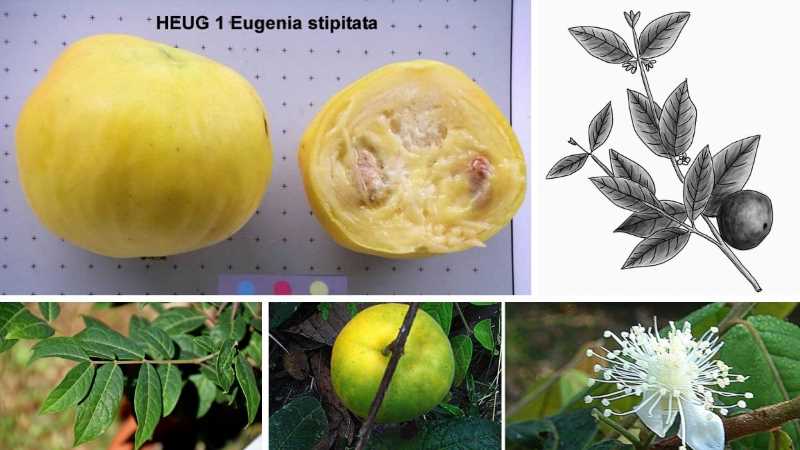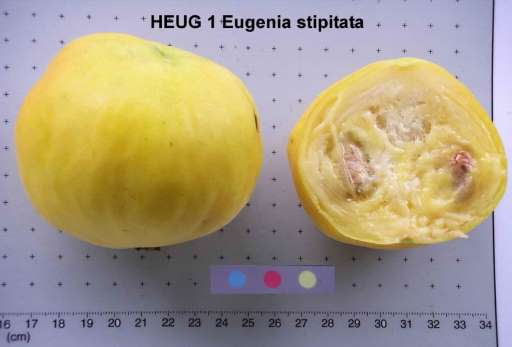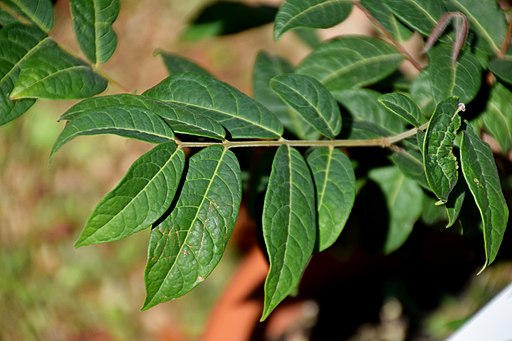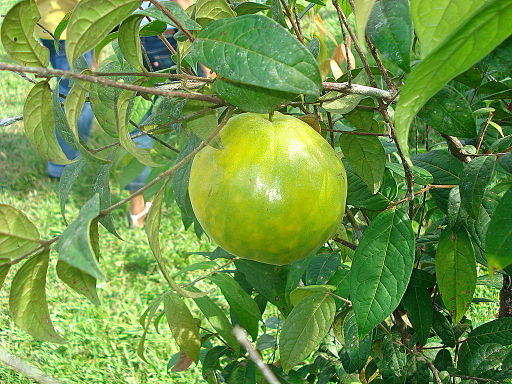
The Araza (Eugenia stipitata ) is a plant, of the Myrtaceae family, native to the western Amazon, where the greatest genetic diversity of the species is concentrated, particularly in the lower basin of the Ucayali River, in the Peruvian Amazon region , near the province of Requena, and the confluence of the Ucayali and Marañón rivers, which flow into the Amazon River.
Other specialists consider that the primary center extends from the Loreto region, in Peru, to the state of Acre, in Brazil , an area where there are spontaneous populations in the wild.
Due to the various properties of the fruit, the plant is considered one of the promising crops of the Amazon.
Scientific name and common names of the arazá
The scientific name of the arazá is Eugenia stipitata (Mc Vaugh) . Its common names are arazá, the most widespread, although it is also called Peruvian guava, Amazonian guava (Peru), Brazilian guava, arazá-boi (Brazil).
✅ Botanical description
The arazá is a shrub or small tree, 1.5 to 5 m tall, with dense foliage, branched from the base, and a rounded crown.
In the Amazon basin there are two ecotypes, one of Peruvian origin and the other Brazilian.
The Peruvian ecotype is highly appreciated for its organoleptic properties, but its fruit is smaller and has 12 to 16 small seeds.
The fruit is a spherical berry flattened upwards. Its skin or epicarp is very thin, 1 mm. The fruit measures 3 to 5 cm long, 4 to 10 cm in diameter, with a weight ranging from 20 to 50 g, and even depending on the cultivar it can weigh between 200 and 400 g.
In the immature state it is green, but, when ripe, the shell of the fruit turns yellow.

The pulp , or mesocarp, is fleshy, thick, juicy, acidic, aromatic and orange in color. It is used in the production of juices, nectars, jellies, even a liquor called arazá wine and yogurth.
The pulp represents 70% of the weight of the fresh fruit.
The arazá, due to its acidity (pH from 2.66 to 3.43), is hardly consumed raw, but rather as a soft drink, made from frozen pulp.
However, its high acidity can be somewhat neutralized by mixing it with other juices.
After being harvested, the fruit is very delicate and deteriorates very easily, so it must be processed immediately.
Some producers pulp it manually, remove the seeds and freeze them in plastic bags to prevent rapid decomposition and take them to markets.
✅ Subspecies
McVaugh described in 1956 two subspecies of Eugenia stipitata, which can be considered independent species, if they are geographically isolated: Essubsp. stipitate Y It is subsp. sorority
Eugenia stipitata stipitata
The subsp stipitata is a tree 12 to 15 m tall, with sparse foliage.
Its fruit is a flattened spherical berry, 3 to 5 cm long, 4 to 7 cm in diameter, and weighing between 20 and 50 g.
The pulp is slightly aromatic and acid, and its seeds are numerous.
Eugenia stipitata sororia
The subsp. sororia is a shrub or small tree, 1.5 to 5 m tall, with dense foliage and a rounded crown.
The fruit is a globose-concave or spherical berry, which measures from 2 to 12 cm long, 1.5 to 15 cm in diameter and weighs up to 420 g., and specimens of 800 g have even been obtained.
Its pulp is juicy, yellowish, aromatic and bittersweet.
It has 3 to 22 seeds. The two subspecies differ in growth habits, number of stamens, fruit size, and reproductive system.
It is held that the subsp. sorority is more productive than the other.
✅ Agronomic practices
The arazá generally grows in fertile soils with good drainage, although it has a great adaptive capacity, as it also grows in poor soils, with low fertility and even poorly drained.

ideal climate
It is thought that the most important factor for the cultivation of arazá is the climate, in particular an average monthly temperature between 18 °C and 30 °C, and a rainfall pattern between 1,500 and 4,000 mm in the year.
The plant thrives without difficulty in areas with a relative humidity of 80%, at an average temperature of 26 °C, and variable annual rainfall between 2,000 and 2,800 mm.
Harvest
The plant produces throughout the year, it is harvested about four times a year , lacking a precise seasonality, which represents a great advantage for its commercialization.
However, another of its most outstanding characteristics is the rapid perishability of the fruit , which constitutes one of the great limitations for its distribution in internal or external markets.
One of the reasons that has affected the expansion of the crop is the lack of knowledge that farmers have about its agronomic management and the use of its fruit.

Each plant in production age produces between 20 and 35 kg of fruit per year. Specialists estimate that its production is highly variable, between 2.5 to 60 tons/ha/year. Others estimate it at 15 t/ha/year (Mejía, Narváez, Restrepo 2006).
The arazá plant begins to produce fruits after the second year of implantation, and commercial production, more abundant, is reached between 5 and 12 years.
It is estimated that the cultivation of arazá begins to be profitable from the sixth year.
✅ Nutritional table of arazá
Araza pulp contains:
- 11.9% protein,
- 49.2% sugars,
- 39% dietary fiber and
- 4% ash.
- Its water content is 90 to 94%.
Amino acids:
Among the main amino acids that it presents are:
- glutamine,
- asparagine,
- To the girl,
- leucine,
- lysine,
- arginine,
- Phenylalanine,
- Isoleucine.
sugars
The fraction of its sugars comprises fructose, sucrose and glucose.
vitamins
The pulp is also a good source of vitamins A (7.75 mg), B1 (8.84 mg) and C (7.7 mg per 100 g of dry pulp).
The assessments of vitamin C content vary considerably among authors. Esmeraldas-Gamboa and Nazareno-Arroyo (2018) made comparisons of vitamin C content between arazá fruits of cultivars from Peru and Brazil, resulting in 31.78, 33.70, respectively.
minerals
On the other hand, its potassium content is high, although it also has other minerals, to a lesser degree, such as calcium, magnesium and phosphorus .
✅ Chemical composition of arazá pulp
The most important chemical component of the arazá is its high concentration of phenolic acids , which increase in the ripening process of the fruit, and decrease in the senescence process, when its rotting is observed. This concentration differs according to the production areas.
An investigation carried out in the Amazonian provinces of Napo and Pastaza, in Ecuador , found that the amount of polyphenols in arazá fruits in Napo was, on average, 947.26 mg-g, while those produced in Pastaza were 837, 14 mg-g (Lescano-Castillo 2016).
Something similar occurred with the measurements of protein content, degrees Brix, fiber and acidity, registering the highest levels for arazá fruits produced in Napo compared to Pastaza.
In such a way that it is thought that the content of polyphenols and the bromatological characteristics are influenced by the ecological conditions of the production site.
✅ Importance of phenolic compounds
Phenolic compounds are responsible for giving antioxidant power to fruits and vegetables, which is a protection against the presence of free radicals and their effects.
It has been found that the highest capacity of antioxidants in a fruit is found in the skin, rather than in the pulp.
It is also known that cooking fruits reduces the activity of antioxidants, with some exceptions, such as tomatoes, whose cooking does not significantly alter the amount of lycopene and its flavonoids.
The antioxidant activity is related to the type of fruit, the variety used and the color of the fruit (Coronado et al 2015).
How do free radicals affect our health?
The free radical is a figure that has in its structure one or more unpaired electrons in its outermost orbital, which makes it highly reactive and key to form other free radicals in a chain.
Oxidative stress (OS) is a disturbance of the balance between prooxidants and antioxidants, with a tendency to shift towards prooxidants, producing changes in biomolecules, which can cause cell death.
This imbalance of the oxidative system is probably at the origin of many cardiovascular, respiratory, neurological, gastric and endocrine system diseases.
It must be taken into account that OS is different from psychological stress, which is frequently experienced by an individual subjected to constant social pressure in their daily life (Coronado et al 2015). EO is associated with cells and the action of free radicals that affect them.
Free radicals are released during human metabolism, but they can increase to high-risk levels due to the continuous exposure of the human body to environmental pollutants, radiation, drugs, stress, pesticides and chemical fertilizers, or the consumption of toxic substances, such as alcohol, tobacco. , drugs, etc
In addition, free radicals can oxidize the protein, lipids and DNA of the organism (Lescano-Castillo 2016), affecting the structure and function of healthy cells in the body, generating mutations that cause degenerative diseases such as cancer.
On the other hand, free radicals have been related to the pathogenesis of at least fifty serious diseases.
The consumption of fruits and vegetables can be a way to neutralize free radicals , and in particular those fruits , such as arazá, which have high concentrations of phenolic compounds, which protect cells against damage caused by the action of free radicals .
✅ Antioxidants in the arazá
Among the antioxidants there are several families of active ingredients such as polyphenols (including flavonoids and tannins) and phytoestrogens.
Among the flavonoids are anthocyanidins (bluish-red from strawberries), catechins (green and black tea), citroflavonoids (citrus orange fruit), isoflavonoids (soy) and proanthocyanidins (in grape seeds and wine). red) (Coronado et al 2015).
Araza fruit is rich in antioxidants. But the high perishability of the fruit decreases its capacity as an antioxidant.
Hence the importance of reversing these deterioration effects, which also affect the appearance of the fruit and its organoleptic qualities.
It is known that the consumer chooses the fruit, taking into account what his perception indicates, that is, its sensory characteristics, and these result from the adequate storage conditions of the product (Hough, Fiszman 2005).
What is very remarkable in the case of arazá, which has an excellent antioxidant capacity . This is evident from its rich content of ascorbic acid (30 mg/per 100 g of base pulp) and its total phenolic compounds (64 mg of gallic acid in 100 g of base pulp).
This group of compounds has antitumor, antiallergic, anti-inflammatory actions, and reduces the risk of suffering from degenerative and coronary diseases, by acting as antioxidants that trap free radicals and as synergistic agents, as is the case of ascorbic acid, with phenols and carotenoids.
The use of natural antioxidants is, apparently, more effective than antioxidants presented in commercial formulas, whose indiscriminate and excessive consumption, and their mixtures with other toxins, can be harmful to the human body.
✅ Araza production
The arazá is a species distributed throughout the Amazon basin, but little cultivated, except in Brazil and Peru, and a little in Ecuador (in the Amazonian provinces), despite its great importance and its high relative prices in the market international.

Perhaps due to its great limitation, as it is a highly perishable product, which presents great problems for its commercialization even in regional markets, and much more for export, unless pulp conservation measures are used that allow it to extend its life. of the product.
Araza, however, is spreading slowly. And there are productive enterprises in the Amazon portions of Colombia and Ecuador.
But there is still much to do.
In Colombia, for example, it is cultivated by small producers, who plant it in small plots and with little technology (Nastur, Benavides, Barrera-Silva, Pardo Rozo 2016).
The arazá plant is threatened by pathogens that negatively alter the appearance of the fruit. This is the case with anthracnose, which manifests itself with yellowish spots on the fruits, and then they begin to blacken.
✅ Medicinal uses
Araza is used in folk medicine for the treatment of DHL cholesterol, diabetes, excess uric acid, and liver and kidney ailments.
Some, considering its intense aroma, have carried out studies on the use of arazá in the production of perfumes (Delgado 2004; Vargas, Rivera and Narváez 2005).
In Colombia there is a perfume called “Arazá” (Martillo-Pazmiño, Loayza G., Duque-Yépez 2014). And even with arazá a moisturizing cream is made, combined with tomato pulp (Villacis-Vargas 2014).
✅ Pulp treatment to preserve it
The transport of the arazá fruit is difficult due to its delicacy and its propensity to rot.

When it is transported, it is done in rigid and resistant containers, and whose capacity must not exceed 15 to 20 kg. Although it is preferred to process its pulp as quickly as possible after harvest, by freezing it.
It is generally recommended that the pulping unit should be located as close as possible to the commercial production area.
The fruits are kept without problems, at room temperature (26 °C) during the first two days, and from that moment their deterioration is manifested.
From the fourth day some sensory characteristics decrease: brown spots appear on the skin of the fruit, the texture softens and its original flavor is lost.
As of the sixth day, its sensory characteristics are severely impaired, and its content of ascorbic acid and its phenolic compounds are notably reduced.
Fruit deterioration can lead to a high generation of reactive oxygen species (EROS), which damage cellular components and are related to degenerative processes.
EROS are produced in plant cells during the maturation process, and are increased during senescence.
The consumption of fruits and vegetables enhances the human antioxidant system. Among the recommended fruits to consume, the arazá stands out for its antioxidant capacity .
Conservation methods
Due to its perishability, various methods have been investigated to preserve the pulp.
slow freezing
The slow freezing treatment at minus 20 °C has been tested, storing it for four months, and evaluating its changes every 15 days.
The treatment managed to preserve the sample with good sensory qualities during the first month of storage, keeping total phenolics, carotenoids and antioxidant activity unchanged, observing changes in texture and in ascorbic acid content (Mejía, Narváez, Restrepo 2006; Vargas , Rivera, Narvaez 2005, Hough, Fiszman 2005).
Combined cooling
Another method of treating the arazá fruit to keep it stored is refrigeration combined with thermal shock or with intermittent shocks, and the use of modified atmospheres.
With these techniques it has been possible to maintain the useful life of the fruit for 15 days, managing to reduce weight loss, softening, browning and susceptibility to rot, maintaining its organoleptic characteristics for a longer time.
Bibliography
- Ariza-Cubillos EA 2012. Determination of the profile of phenolic compounds in arazá (Eugenia stipitata). Thesis. Science Faculty. National university of Colombia. PDF
- Coronado H., M., Vega and León S., Gutiérrez T., R. ; Vázquez F, M. Radilla V., C. Antioxidants: current perspective for human health. Rev. Chile. Nourish Vol. 42 (2), June. Source
- Delgado JL 2004. Effects of cryo-concentration processing on the “flavor” of arazá pulps. Master’s Thesis. Science Faculty. National university of Colombia. Bogota. Source
- Esmeraldas-Gamboa JE, Nazareno-Arroyo. IJ 2018. Bromatological study of the Ecuadorian araz{a species (Eugenia stipitata) of different geographical origin. Thesis. Faculty of Chemical Sciences. Guayaquil University. Source
- FAO-OTCA. 2016. Technical manual. Araza (Eugenia stipitata). Cultivation and Use. Caracas: ACTO-Pro-Tempore Secretariat. Source
- Hernandez MS, Bardales XI 2007. Harvest and post-harvest management manual of arazá fruits (Eugenia stipitata McVaugh) in the Colombian Amazon. Amazonian Institute for Scientific Research / ASOHECA. Bogota: SINCHI. Source
- Hough G, Fiszman S. 2005. Estimation of sensory shelf life of foods. Spain: CYTED Program, 13-23. Source
- Lescano-Castillo AM 2016. Evaluation of the functional properties of arazá (Eugenia stipitata) in different climatic zones. Thesis. Digital Repository. Amazon State University (Ecuador).
- Martillo-Pazmino I., Loayza G., A. Duque-Yépez A. 2014. Caribeña.uned.net/wp-content/up loads/arazá.pdf¨?
- Mauirica-Vargas A., Rivera-Carnelo AP, Narváez-Cuenca CE 2005. Capacity during the maturation of arazá ( Eugenia stipitata McVaugh ). Colombian Journal of Chemistry. Vol. 34 (1), 57-65. Source
- Mejia LJ, Narvaez CE, Restrepo LP 2006. Physical, chemical and sensory changes during frozen storage of arazá pulp (Eugenia stipitata McVaugh). Colombian Agronomy, Vol. 24 (1), Jan-Jun, 87-95. National university of Colombia. PDF
- Montes-Nájera GM 2015. Economic-financial analysis of arazá pulp exports. Master’s Thesis. School of Economics. Guayaquil University. Source
- Nastur IR, Benavides AA, Barrera-Silva AL 2016. Agroindustrial potential of Amazonian fruits in the department of Caquetá. Magazine of the Faculty of the Americas. FACE 6 (1), 96-101. University of the Amazon, Colombia.
- Niño M., Otálvoro M. 2013. The Araza in Colombia. Characteristics, production and export potential. Bogota. PDF
- Ramos-Botia, LM, Rodriguez-Sanchez SE 2009. Production and marketing of arazá fruit pulp, an exotic fruit from the Amazon, in the city of Bogotá. Bogotá: University Minute of God. Source
- Rogez H., Buxaut R., Mignolet ., Souza JNS, Silva EM, Larondelle Y. 2004. Chemical composition of the pulp of three typical amazonian fruits: arazá-boi ( Eugenia stipitata ), bacuri ( Platonia insignis ), and copauzu ( Theobroma grandiflorum ). European Food Research and Technology, 218(4), 380-384.
- Sanchez-Salguero SD 2015. Project for the export of arazá pulp to the North American market. Thesis. Faculty of Administrative Sciences. Guayaquil University. PDF
- Vargas AM, Rivera CAP, Narvaez CE 2005. Antioxidant capacity during the maturation of arazá (Eugenia stipitata McVaugh). Colombian Journal of Chemistry. 34, 7-65. PDF
- Villacis-Vargas CE 2014. Preparation and verification of the in vivo efficacy of moisturizing cream with tomato extract (Lycopersicon esculentum, Solanaceae) and arazá ( Eugenia stipitata, Myrtaceae). Thesis. Salesian Polytechnic University, Quito, Ecuador. Despace.ups. edu.ec/handle/123456789/7791. PDF

Dr. Rafael Cartay is a Venezuelan economist, historian, and writer best known for his extensive work in gastronomy, and has received the National Nutrition Award, Gourmand World Cookbook Award, Best Kitchen Dictionary, and The Great Gold Fork. He began his research on the Amazon in 2014 and lived in Iquitos during 2015, where he wrote The Peruvian Amazon Table (2016), the Dictionary of Food and Cuisine of the Amazon Basin (2020), and the online portal delAmazonas.com, of which he is co-founder and main writer. Books by Rafael Cartay can be found on Amazon.com
This post is also available in:
![]() Español (Spanish)
Español (Spanish)
